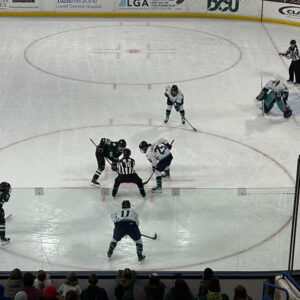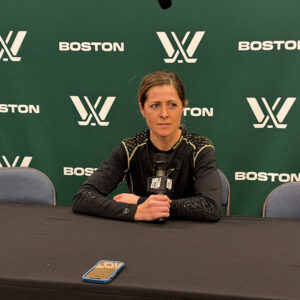 Lowell, Mass. –- Somewhere, Dorothea O’Donoghue must be smiling.
Lowell, Mass. –- Somewhere, Dorothea O’Donoghue must be smiling.
The paint is still wet, but the Professional Women’s Hockey League (PWHL) picture looks promising, especially when one takes a long view. This weekend’s action came six weeks after the circuit started its 24-game schedule, six months after the league was founded, and a little more than a century after organized women’s hockey first took the ice in Boston.
Boston’s entry in the new PWHL dropped a 2-1 OT decision to their New York opponents Saturday in a game that was fast, physical, smart, and spirited. New York’s Alex Carpenter, one of the league’s points leaders, concluded the contest with a wrister from inside the left circle with 2:32 left in the extra stanza. Emma Woods put New York on the board with a first-period marker, and Boston’s Megan Kellar tied the game with just 1:04 left in the third. But on this day, it was the goaltenders who shone brightest, especially New York’s Corinne Schroeder who turned away 31 of 32 shots. New York’s win leapfrogged them past Boston into fourth place in the six-team league, whose franchises have distinctive colors and burgeoning local followings, but no nicknames (yet).
How’d we get here? In early 1917, the Boston Globe followed the fortunes of the Arena Girls’ Hockey Club, the first reported collection of local women playing the game with standard equipment and uniforms on rented indoor ice. Wartime demands in 1917 and fire in the old Arena in 1918 effectively postponed the endeavor, but it returned in December 1920 after the new Arena was built in the form of the Boston Girls’ Hockey Team. The Globe reported: “The leader of this group weighs only 115 pounds and is only 5 feet 2 inches tall. She has … grit … and muscle … [and] is as strong as many men… Her name is Dorothea O’Donoghue and she works … in the Insurance Department … in the State House…” A goaltender, in 1920 she aimed to “enhance her reputation” that she earned as a puckstopper “for the girls hockey team that Boston had several years ago.” O’Donoghue’s team operated for one season, playing games against sides from New York and Philadelphia. By 1922, it had collapsed, victim of an unsupportive local press and competition for indoor ice time from local boys’ and men’s teams.
 Serious women’s hockey in New England didn’t reappear until college women at schools like Brown and New Hampshire and girls’ club hockey teams like the Massport Jets breathed new life into the game in the 1960s and 70s. In the latter decade, the influence of second-wave feminism, which insisted on equal treatment for boys and girls in athletics (and all things), and the landmark Title IX legislation, which mandated that federally funded institutions provide equal opportunities (including athletic scholarships) for women and men, turned the tide for women’s hockey. For 50 years, that legal framework has made NCAA women’s hockey a crucible for developing elite talent, and those teams have in turn provided models of elite athletic accomplishment and motivation for girls across the region. When women’s international tournaments were first staged in the late 1980s (and sanctioned by the International Ice Hockey Federation in 1990), New England women were among the US National Team’s best contributors, and they were among those who won gold when women’s ice hockey was added to the Winter Olympics in Nagano, Japan in 1998.
Serious women’s hockey in New England didn’t reappear until college women at schools like Brown and New Hampshire and girls’ club hockey teams like the Massport Jets breathed new life into the game in the 1960s and 70s. In the latter decade, the influence of second-wave feminism, which insisted on equal treatment for boys and girls in athletics (and all things), and the landmark Title IX legislation, which mandated that federally funded institutions provide equal opportunities (including athletic scholarships) for women and men, turned the tide for women’s hockey. For 50 years, that legal framework has made NCAA women’s hockey a crucible for developing elite talent, and those teams have in turn provided models of elite athletic accomplishment and motivation for girls across the region. When women’s international tournaments were first staged in the late 1980s (and sanctioned by the International Ice Hockey Federation in 1990), New England women were among the US National Team’s best contributors, and they were among those who won gold when women’s ice hockey was added to the Winter Olympics in Nagano, Japan in 1998.
Until now, the attempt to parlay the success of the game into a single, perennial, and truly professional league has stumbled. Energy from Nagano propelled the formation of the National Women’s Hockey League (1999-2007), which was replaced by the Canadian Women’s Hockey League (2007-2019), a non-profit organization where the world’s best players played. The National Women’s Hockey League, a for-profit, US-based circuit founded in 2015, changed its named to the Premier Hockey Federation in 2019, and operated until 2023. In any form, these leagues all suffered financially and struggled to provide decent wages and health care for their players, who had to take on full-time jobs to make ends meet. In 2022, elite women’s players formed the Professional Women’s Hockey Players Association, who, though they played in occasional Canada-US “friendlies,” effectively went on strike, refusing to join a new league until one could guarantee decent pay and health care benefits.
Enter the PWHL. Owned by the Mark Walter Group and headed by Commissioner Jayna Hefford, the league has sound financial footing. Each team’s players make an average of $55,000, with elite players earning $80,000 and others a minimum of $35,000. Players enjoy housing stipends, meal allowances, an abundance of trainers and coaches, and equipment. “It’s the little things that make all the difference,” Boston forward and USNT veteran Gigi Marvin reflected. “We didn’t have any of that in the past.”
It’s been a long journey. At the masthead of the league’s website is a telling motto – “Ice Time. Earned.”
 The result is a product that the league can sell. Fast, physical, and smart have long been the trademark elements of men’s hockey, and the standard against which women’s hockey has for so long been judged and found wanting. That’s changing. The pace is “right up there with the best of international play,” Marvin claimed. The PWHL’s decision to alter the rules to allow bodychecking when a player is in pursuit of the puck has been met with both players’ and fans’ approval. In the Boston-New York tilt, fans erupted when the game got gritty. And the high quality of goaltending may be the highlight of league play so far. “So many chances,” Boston coach Courtney Kessel remarked, “not enough goals.”
The result is a product that the league can sell. Fast, physical, and smart have long been the trademark elements of men’s hockey, and the standard against which women’s hockey has for so long been judged and found wanting. That’s changing. The pace is “right up there with the best of international play,” Marvin claimed. The PWHL’s decision to alter the rules to allow bodychecking when a player is in pursuit of the puck has been met with both players’ and fans’ approval. In the Boston-New York tilt, fans erupted when the game got gritty. And the high quality of goaltending may be the highlight of league play so far. “So many chances,” Boston coach Courtney Kessel remarked, “not enough goals.”
The shape of the league is still in question. “I think we’re still evolving right now,” New York coach Howie Draper said. “We’ve got brand-new teams and brand-new staffs. Every game we see something different.” Kessel, on the other hand, says that PWHL teams have begun to develop their own characters: “Montreal is the most physical, Ottawa plays aggressively all over the ice, and New York plays run and gun.”
Challenges lie ahead, including signs of a divide between haves and have-nots at the box office and in terms of media attention. On February 16, a record-breaking 19,285 fans attended a Montreal-Toronto game at the Scotiabank Center in Toronto; though about 2,500 fans were present for the New York-Boston tilt, only about 1,780 were in Lowell’s Tsongas Center for Boston’s February 14 home game against Toronto. While press coverage in Toronto and Montreal is robust, the same can’t be said for Boston’s franchise, which gets comparatively little. At the New York game, neither of the city’s dailies sent reporters and the post-game press scrum was staffed by three student bloggers and me. While the league hopes to capitalize from expansion (PWHL games are scheduled to take place in Pittsburgh and Detroit next month), there is some question as to whether enlarging the circuit will water down talent at a time when the league is trying to convince fans that it’s the real deal.
Still, on a chilly Saturday afternoon in Lowell, Massachusetts, in front of a small-but-loud crowd of devoted fans, it’s the hockey that matters most to these women athletes; the chance to play games in a league that means something. “It’s legit. It’s real. It’s here,” Marvin said.
Dorothea O’Donoghue couldn’t have said it better.
Andrew Holman teaches sport history at Bridgewater State University in Massachusetts. His books include Hockey: A Global History (with Stephen Hardy, 2018), and “A Hotly Contested Affair”: Hockey in Canada. The National Game in Documents (2020).








